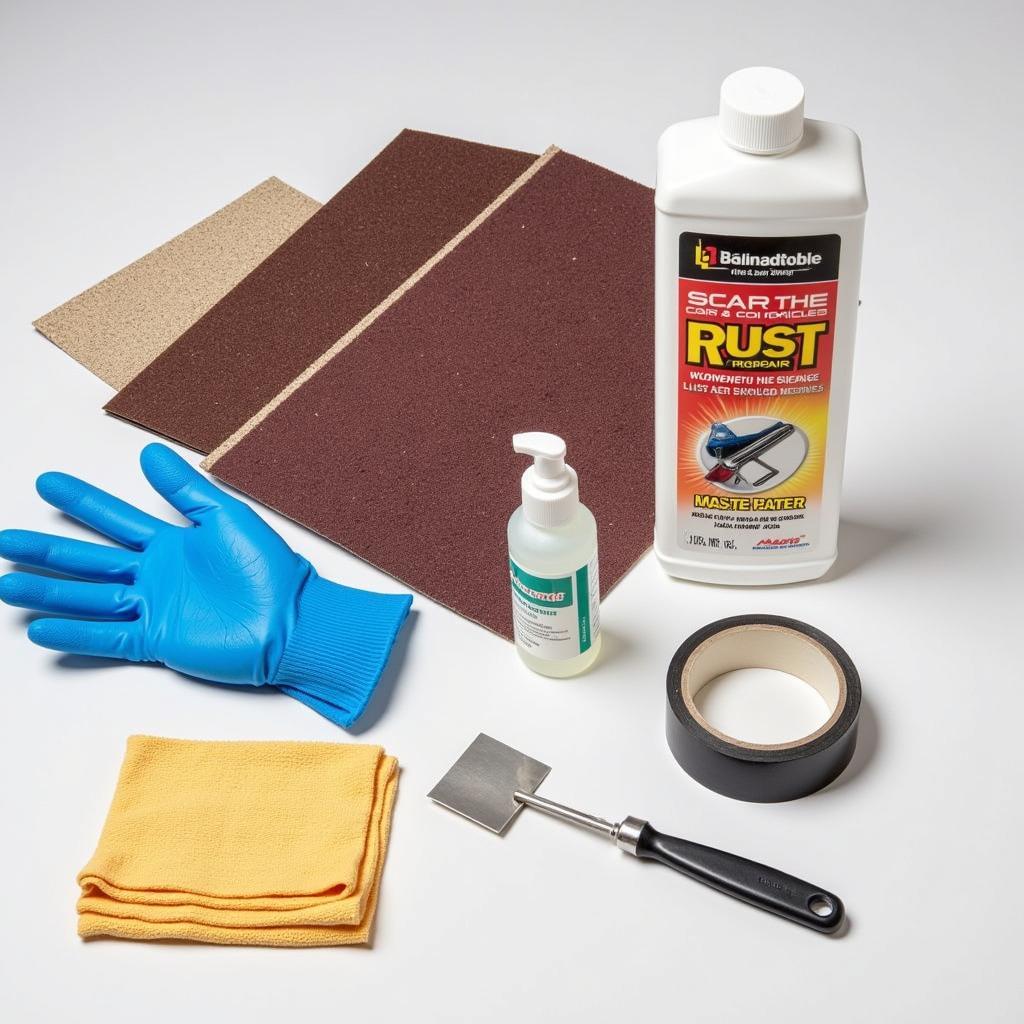Rust is a common problem for car owners, especially in areas with a lot of salt or moisture. It can start as small spots and eventually spread to larger areas, causing significant damage to your car’s body. Fortunately, you can fix minor rust spots yourself, saving you money and extending the life of your vehicle. This article will guide you through the process, step by step.
What You’ll Need
Before we start, you’ll need to gather the following materials:
- Rust converter: This solution transforms rust into a stable substance that can be painted over.
- Sandpaper: Choose different grits, starting from coarse (80-120 grit) and gradually moving to finer grits (220-400 grit).
- Primer: This helps the paint adhere to the surface properly.
- Paint: Use a paint that matches your car’s color.
- Masking tape: This helps you create clean lines and prevent paint from getting on unwanted areas.
- Cleaning cloths: For wiping away dust and debris.
- Protective gloves and mask: This protects you from the dust and chemicals.
- A small brush or paint roller: Apply primer and paint.
- A scraper: To remove loose rust.
- Optional: A drill with a wire brush attachment to remove stubborn rust.
Step-by-Step Guide to Fixing Minor Rust Spots
Follow these steps to successfully repair those minor rust spots on your car:
- Prepare the area: Start by cleaning the area around the rust spots with soap and water. Rinse thoroughly and dry the surface completely. This removes any dirt or debris that could interfere with the repair process.
- Remove loose rust: Use a scraper to remove any loose rust. This ensures the rust converter can effectively penetrate the remaining rust.
- Apply rust converter: Apply the rust converter to the affected area according to the instructions on the product label. Allow the converter to dry completely before moving on.
- Sand the area: Begin with coarse sandpaper (80-120 grit) and gradually move to finer grits (220-400 grit) to smooth out the surface and create a solid foundation for the primer.
- Clean the area: After sanding, wipe away any dust or debris with a clean cloth.
- Apply primer: Apply a thin layer of primer to the prepared area. Allow the primer to dry completely before moving on.
- Apply paint: Apply a thin coat of paint that matches your car’s color. If needed, apply multiple thin coats, allowing each coat to dry completely before applying the next.
- Let the paint dry completely: Allow the paint to dry thoroughly, following the instructions on the paint label.
- Enjoy your repaired car: After the paint has cured, the rust spots will be gone, leaving your car looking its best.
 Car rust repair tools
Car rust repair tools
Additional Tips:
- Wear protective gear: Always wear gloves and a mask when working with rust converter, sandpaper, primer, and paint.
- Work in a well-ventilated area: This prevents the fumes from harming you.
- Use a light touch: Don’t apply too much pressure when sanding or applying primer and paint.
- Clean up properly: Clean up any spills or messes immediately.
- Inspect regularly: Even after repairing the rust, it’s crucial to inspect your car regularly for signs of new rust spots.
 Car rust before and after repair
Car rust before and after repair
Why Rust Prevention is Crucial
“Rust is a relentless enemy,” says John Smith, a seasoned car repair professional, “It can slowly destroy your car’s body, eventually leading to major repairs or even a total loss.” John emphasizes that “early detection and treatment are key to minimizing rust damage and keeping your car in top shape.”
FAQs
How can I prevent rust from forming?
You can minimize rust by keeping your car clean and dry, especially after driving in snowy or rainy conditions. Regular car washes and waxes can help create a protective barrier.
What are the signs of rust?
Look out for small, reddish-brown spots on your car’s body, especially in areas prone to moisture, like wheel wells, undercarriage, and around the doors.
What happens if I don’t fix rust spots?
Ignoring rust spots will lead to more extensive damage, requiring more expensive repairs, or potentially even replacing the entire body panel.
How can I get help with fixing rust spots?
If you’re not comfortable fixing rust spots yourself, you can always contact a professional car body shop. They have the experience and equipment to tackle even the most challenging rust problems.
What are some other car maintenance tips?
Regular maintenance is essential for keeping your car running smoothly. This includes oil changes, tire rotations, fluid checks, and regular inspections. You can find a wealth of information and expert advice on our website, autotippro.com.
Contact us today at +1 (641) 206-8880 or visit us at 500 N St Mary’s St, San Antonio, TX 78205, United States for all your car maintenance needs.






Leave a Reply